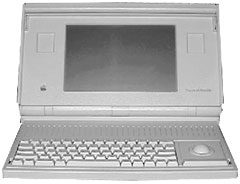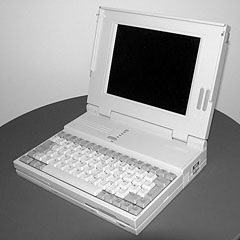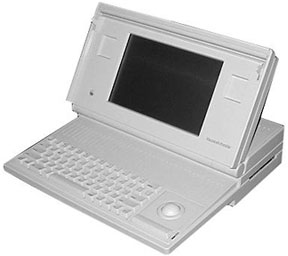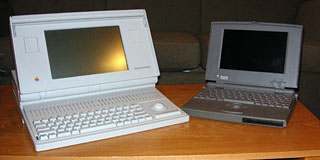Some modern things we just take for granted, like a stove, an oven, ora TV.
We sometimes also take laptop computers for granted. Nowadays youcan buy them dirt cheap at your local Best Buy or Walmart.
But a lot of times we forget what started it all: It was Apple andthe Macintosh Portable. Sure,there were laptops before the Mac Portable, but they were ugly, slow,and not user-friendly.

Apple decided to get into the portable market and save notebookusers from certain death caused by text-based MS-DOS. On September 20,1989, the Macintosh Portable was unveiled at a suggested retail priceof US$6,500. It wasn't a beauty queen at 16 lb., but it was a Mac(i.e., user-friendly).
And it was fast.
It had a whopping 16 MHz 68000 CPU, making it twice as fast as theMacintosh SE, and it matchedthe Mac IIcx on some benchmarks!The Portable shipped with 1 MB of RAM (expandable to 9 MB)and an optional 20 MB hard drive.
Just imaginethat back in 1989, when Windows 2.1 was considered state of theart.
 The main competitor was the nearly 7 lb. Compaq LTE family ofnotebooks, running various editions of MS-DOS on its CGA displayand shipping with a 500-page book that told you how to changedirectories, delete a file, open the word processor - and how you mustlet the RAM check on POST pass without canceling "or your motherboardand/or Random Access Memory card may be permanently damaged and youwill have to contact Compaq, Inc. blah, blah".
The main competitor was the nearly 7 lb. Compaq LTE family ofnotebooks, running various editions of MS-DOS on its CGA displayand shipping with a 500-page book that told you how to changedirectories, delete a file, open the word processor - and how you mustlet the RAM check on POST pass without canceling "or your motherboardand/or Random Access Memory card may be permanently damaged and youwill have to contact Compaq, Inc. blah, blah".
How easy is that for someone who has never used a computerbefore?
The Macintosh Portable was as user-friendly as any Mac, and youcould take it with you.
 As the title of this articlesuggests, this 16-pound baby started a revolution. Two years later, onOctober 21, 1991, the firstPowerBooks were unveiled. These babies were slim. They were nothinglike the Compaq LTE.
As the title of this articlesuggests, this 16-pound baby started a revolution. Two years later, onOctober 21, 1991, the firstPowerBooks were unveiled. These babies were slim. They were nothinglike the Compaq LTE.
In 2001, the TitaniumPowerBook G4 was introduced, setting a whole new standard forportable computing. It had a blazing-fast 400 MHz or 500 MHz PowerPC G4processor and was a hell of a lot faster than any Wintel notebook.
In 2003, the iBook G4s were introduced. Just like the TiBook beforethem, these 'Books set a whole new standard, this time in consumernotebooks.
And now, in 2008, the 2.6 GHz Core 2 Duo MacBook Pro has beenintroduced.
 This was all thanks to the Macintosh Portable. The PowerBookbrand spun off from the Portable. The PowerBook 100 is basically a Portable inminiature - Apple hired Sony to make the components small enough to fitin a regular notebook case. (If you don't believe me, install System6.08L on your PB 100: It will be identified as a MacintoshPortable.)
This was all thanks to the Macintosh Portable. The PowerBookbrand spun off from the Portable. The PowerBook 100 is basically a Portable inminiature - Apple hired Sony to make the components small enough to fitin a regular notebook case. (If you don't believe me, install System6.08L on your PB 100: It will be identified as a MacintoshPortable.)
In 1999, the iBook brand spun off from PowerBook as a line ofaffordable consumer notebooks. The MacBook brand replaced the iBookwhen Apple moved to Intel processors (it is also considered thereplacement of the 12" PowerBook). And finally, the MacBook Pro brandreplaced the PowerBook brand as Apple's top-of-the-line notebooks.
What if Apple had never created the Portable? Compaq's notebookswould still be 1980s white, Acer's notebooks would still be stuck onthat black and silver color scheme, and Dell probably wouldn't exist.And notebooks would never have become standard for many people. TheOLPC project might never have existed if Apple hadn't started thisrevolution.
On Thursday, I will pick up a huge load of old Macs, including somePower Computing models, LCs, and aMacintosh Portable. Those Macs will probably become columns here - sostay tuned. 


 The main competitor was the nearly 7 lb.
The main competitor was the nearly 7 lb.  As the title of this articlesuggests, this 16-pound baby started a revolution. Two years later, onOctober 21, 1991,
As the title of this articlesuggests, this 16-pound baby started a revolution. Two years later, onOctober 21, 1991,  This was all thanks to the Macintosh Portable. The PowerBookbrand spun off from the Portable. The
This was all thanks to the Macintosh Portable. The PowerBookbrand spun off from the Portable. The 
